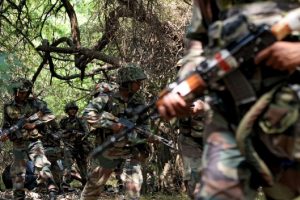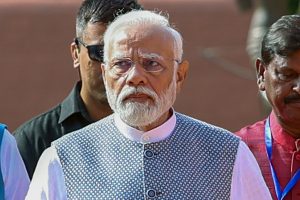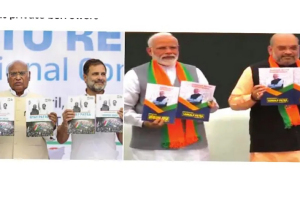Standing atop the majestic Jebel Harim, the highest mountain in the Musandam region, is like a journey back in time, to perhaps the Pre-Historic Era when this area in all likelihood was submerged in water. This bit of information comes as a bit of a surprise, given the tropical desert climate of the region.
“We do get some rain but the weather remains dry most of the time,” says Eldho Verghese. Originally from Kerala, he is among many who have made Oman the second largest country in the Gulf, their home.
The tour coordinator has assigned Fadia, the driver, to give us a taste of this slice of Musandam Governorate comprising a mountainous peninsula on the coast of the Strait of Hormuz. What is interesting is that this exclave lies up north, separated from the rest of the country by the United Arab Emirates. We had reached Khasab earlier in the day after an hour-long Oman Air flight from the capital, Muscat.
Advertisement
“We’re very fond of your films. The last one we saw, Secret Superstar, was very good,” he smiles. Fadia, a native of this region, beams on learning we’re from India. As we drive towards Jebel Harim that stands at 2,087 metres, he tells us that the quiet town of Khasab in its present avatar goes back to just about 40 years.
“It was just a small fishing village earlier. After the present Sultan Sayyid Qaboos bin Said Al Said took over in 1970, he has modernised Oman considerably,” he adds.
The smart little town now has schools for children, a hospital, and supermarkets as well as a number of hotels catering to the tourists who come to enjoy the scenic views of this “Norway of Arabia.”
Driving past starkly barren mountain ranges, we reach the stretch housing fossils and rock engravings that go back millions of years. Binoo, the other guide with us, pours water on the dusty surfaces and their original forms start emerging. Some fascinating fossils of fish clearly show the existence of water in these now dry higher reaches.
“Someone has tried pulling out these precious fossils with a knife but has been obviously unable to do so,” says Binoo, pointing to a rock that shows evidence of a struggle. As we stand, enjoying the strong breeze and the splendid views of the waters down below, Fadia tells us that some old caves where people once lived in have also survived the passage of time. The inhospitable terrain seems to have now driven everyone out except for an army unit stationed here.
Back at sea level, we visit the 17th century Khasab Fort built by the Portuguese. Right from the canons at the entrance to the wooden dhows inside and the other objects including weapons, jars, jewellery, clothes and wedding decorations on display, the historic sandstone structure does not fail to impress.
Besides at the supermarket, Eldho and his Indian mates often meet at their places of worship. A house has been converted into a church where a Roman Catholic priest from Muscat comes for service once a month. There is a temple here too, “but its facade looks like a regular flat. All of us from India and Pakistan live here like bhai-bhai, there is no acrimony,” adds a worker from Pakistan, at the supermarket.
The next morning has been reserved for the toast of Musandam, a dhow cruise to see the fjords of the area. Steep and craggy desolate mountains that seem to rise straight out of the sea are an awe-inspiring sight as we share space in the dhow with a family from France and a friendly crew from Bangladesh that has prepared an excellent lunch and offers interesting anecdotes about life in these parts.
Not to forget details of the Telegraph Island named after the telegraph cable repeater station that was built by the British in 1864. This is the place where the term “go round the bend” is believed to have originated, for tired of their posting here; young British officers would always be looking to go to India, taking the route round the bend in the Strait of Hormuz.
Besides snorkelling to enjoy charming views of the water, the dhow cruise also offers a date with dolphins. As the wooden boat speeds ahead, these sea creatures race alongside us, jumping joyfully in the foamy ripples and providing amazing photo opportunities.
Having savoured the charms of Khasab, that incidentally is perfect for an extended weekend holiday destination since it is not too far from India, we decided to enjoy the myriad offerings of Muscat, the capital of Oman, that delights right from the moment one lands at its beautifully laid-out international airport complete with towering palm trees and cacti gardens.
Having come suitably attired for a tour of The Sultan Qaboos Grand Mosque, we give ourselves a final touch by wearing scarves over our heads for a visit into its haloed environs. Comprising a beautiful dome and five towers that incidentally, represent the five pillars of Islam, the Grand Mosque has an Indian connection as well. Besides being inspired by the Taj Mahal, the sandstone used for its construction was transported all the way from India.
As we stand inside its huge prayer hall that can house over 20,000 people at a time, the guide here points to the dexterously woven Persian carpet. “It was hand-made by over 600 women over a period of four years,” he says. Another piece-de-resistance here are the stunning chandeliers, the 6, 00,000 bulb Swarovski crystal one in the centre complemented by 16 smaller ones all across the hall.
Besides the National Museum that offers a peek into the many fascinating chapters of Omanese history, a visit to the Amouage Perfume Factory harks back to the country’s centuries old perfume heritage. Watching the distillation process that goes into creating the perfumes is fascinating and the lady taking us around tells us, that the Amouage makes around 49 kinds of perfumes and produces more than 25,000 bottles a week.
Stepping into the Royal Opera House is like being transported into a grand Parisian music house. It was built in 2011 on the orders of Sultan Qaboos, who was himself a connoisseur of classical music, keen to have a world-class structure dedicated to music in Oman.
With seating for about 1,100 persons, it has since seen performances by famous artists from across the world. And offering a moment of pride for all Indians, the list also displays the name of the legendary Indian artist, L Subramanyam, who performed in a violin recital here, in 2013.
Set aside a couple of hours for the Muttrah Cornish, to soak in the traditional flavour of Oman. Admiring the calm sea where the Sultan’s liner, barges and dhows have been parked, we walk towards the labyrinthine lanes of the souq, lined with shops run not just by Omanese but also several Bangladeshis who are happy to speak to us in Hindi. This is a perfect place to pick up not just souvenirs but also boxes of traditional Omanese sweets.
We decided to bring the curtains down on our Oman experience with a bit of adventure, dune-bashing on the Sharqiya Sands. On route to this part of the country, we stopped to meet some Bedouin people, who are part of the 30 nomadic tribes of the area. Sitting inside her traditional hut, wearing a chintz abaya and a floral hijaab, an elderly lady smiles at us in welcome. A request for a photo is first turned down and then granted but only after she has hidden her face behind a mask.
Al Ghulazi, a young teacher visiting the family who understands English says that women wear masks to protect their faces against the hot sand and dust. “It’s not a sign of oppression. In fact, women enjoy wearing them,” he asserts.
As Ahmed, our driver, does not want us to miss the magic of the sunset on the dunes, we move on. Soon after the mandatory deflation of the tyres to ride over the shifting desert dunes, we sit strapped inside, as our skilled driver races across the undulating land leaving behind huge clouds of dust. And then, as the sun gets set to hide its fiery orb in the far distance, we sit down to enjoy the spectacular sight with cups of some traditional coffee and halwa.
Advertisement











